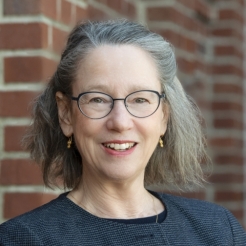Julia Brody, PhD

Dr. Julia Brody is a nationally recognized expert on environmental chemicals and breast cancer, as well as a leader in community-based research and public engagement in science. She joined Silent Spring as executive director in 1996, shortly after its founding. She led the organization for 28 years, transforming Silent Spring into a leading authority on environmental chemicals and women's health.
Dr. Brody’s current research focuses on reporting back to people who participate in environmental health studies to inform them of their own chemical exposures. Her team developed the Digital Exposure Report-Back Interface (DERBI)—a web-based tool for making high-quality personalized reports practical in studies of any size, and is currently adapting the tool for smartphone-based reports. She is also studying what Americans know about endocrine disruptors—as part of the emerging field of environmental health literacy.
Her interest in returning exposure results grew out of Silent Spring Institute’s Household Exposure Study, the first comprehensive assessment of exposure to endocrine disrupting compounds in homes. Results were the first to show that consumer products are a major source of people’s exposure to these chemicals. The study later expanded from Cape Cod, Massachusetts, to Richmond and Bolinas, California, in a project connecting breast cancer advocacy and environmental justice. The study was the first to discover high exposures to flame retardants in California, ultimately leading to revisions in the state’s flammability standards, which had implications nationwide.
Dr. Brody led a critical review of epidemiologic studies published in the past ten years on breast cancer and environmental pollutants. The study was a follow-up to a landmark state-of-the-science report she led that was published in 2007 in the American Cancer Society’s peer-reviewed journal, Cancer. The report included a review on animal mammary gland carcinogens, which provided a roadmap for studying these chemicals in humans. Brody was the principal investigator of the Cape Cod Breast Cancer and Environment Study, including a case-control study of 2,100 women. The study was the first to measure estrogenic chemicals in groundwater and in drinking water.
Brody’s research has been supported by the National Institutes of Health, the California Breast Cancer Research Program, and the National Science Foundation. She is the co-PI of an NIH T32 training grant in collaboration with Northeastern University. Her research collaborators also include investigators at Harvard University, University of California, Berkeley, and elsewhere.
The U.S. Environmental Protection Agency recognized Dr. Brody’s research with an Environmental Merit Award in 2000. In 2002, she presented one of the Distinguished Lectures at the National Cancer Institute and spoke at the 2009 President’s Cancer Panel where she highlighted the need to integrate biological evidence with human studies to prevent cancers. She has served on the National Advisory Environmental Health Sciences Council and is currently an advisor to the California Breast Cancer Research Program and breast cancer activist organizations.
Dr. Brody is a Research Associate in Epidemiology at the Brown University School of Public Health. She earned her PhD at the University of Texas at Austin and her AB at Harvard University.
Projects
Publications & Presentations
Boronow, K.E. and J.G. Brody. 2025. What do people need to know about endocrine disrupting chemicals and health? A mental models approach using focus groups of community-engaged research teams and a national survey. BMC Public Health. doi: 10.1186/s12889-025-25561-4
Franklin, E.T., K.E. Boronow, J.L. Ohayon, A. Momplaisir, J. Steele, C.K. Smith, L. Taylor, B.D. Brock, K.A. Grayson, K. Edgecombe, B.S. Harris, K.N. Pender, I.B. Kola, A.A.M. Llanos, D.K. Teteh-Brooks, L. Marcelin, J.G. Brody, R.E. Dodson. 2025. The Power of Strategic Social Media Influencer Communication to Improve Black Women’s Knowledge and Awareness of Environmental Endocrine Disrupting Chemicals: Surveys of Instagram Users. Journal of Medical Internet Research. doi: 10.2196/66128
Shakti, R., J.E. Kay, E.T. Franklin, J.L. Ohayon, J.G. Brody, M.B. Terry, R.A. Rudel. 2024. Why the UN treaty on plastics can reduce early onset cancers. Environmental Science & Technology Letters. doi: 10.1021/acs.estlett.4c00942
Kay, J.E., J.G. Brody, M. Schwarzman, R.A. Rudel. 2024. Application of the Key Characteristics framework to identify potential breast carcinogens using publicly available in vivo, in vitro, and in silico data. Environmental Health Perspectives. https://doi.org/10.1289/EHP13233
Korfmacher, K.S. and J.G. Brody. 2023. Moving Forward with Reporting Back Individual Environmental Health Research Results. Environmental Health Perspectives. 131(12). https://doi.org/10.1289/EHP12463
Boronow, K.E., B. Cohn, L. Havas, M. Plumb, J.G. Brody. 2023. The Effect of Individual or Study-Wide Report-Back on Knowledge, Concern, and Exposure-Reducing Behaviors Related to Endocrine-Disrupting Chemicals. Environmental Health Perspectives. 131(9):097005. doi:10.1289/EHP12565.
Ohayon, J.L., S. Rasanayagam, R.A. Rudel, S. Patton, H. Buren, T. Stefani, J. Trowbridge, C. Clarity, J.G. Brody, R. Morello-Frosch. 2023. Translating community-based participatory research into broadscale sociopolitical change: insights from a coalition of women firefighters, scientists, and environmental health advocates. Environmental Health. https://doi.org/10.1186/s12940-023-01005-7
Cordero, N.R.C., I.L. Previdi, H.R. Torres, I. Ayala, K.E. Boronow, A.S. Rivera, J.D. Meeker, A. Alshawabkeh, J.F. Cordero, J.G. Brody, P. Brown, C.M.V. Vega. 2023. Mi PROTECT: A personalized smartphone platform to report back results to participants of a maternal-child and environmental health research cohort program in Puerto Rico. PLOS Digital Health. 2(1): e0000172. doi: 10.1371/journal.pdig.0000172
Oksas, C., J.G. Brody, P. Brown, K.E. Boronow, E. DeMicco, A. Charlesworth, M. Juarez, S. Geiger, S.L. Schantz, T.J. Woodruff, R. Morello-Frosch. 2022. Perspectives of peripartum people on opportunities for personal and collective action to reduce exposure to everyday chemicals: Focus groups to inform exposure report-back. Environmental Research. 212(Pt A):113173. doi: 10.1016/j.envres.2022.113173.
Brody, J.G., P.M. Cirillo, K.E. Boronow, L. Havas, M. Plumb, H.P. Susmann, K.Z. Gajos, and B.A. Cohn. 2021. Outcomes from Returning Individual versus Only Study-Wide Biomonitoring Results in an Environmental Exposure Study Using the Digital Exposure Report-Back Interface (DERBI). Environmental Health Perspectives. 129(11):117005. doi: 10.1289/EHP9072
Dodson, R.E., R.W. Setzer, J.D. Spengler, J.G. Brody, R. A. Rudel &. J.G. Cedeño Laurent. 2021. Influence of living in the same home on biomonitored levels of consumer product chemicals. Journal of Exposure Science & Environmental Epidemiology. 32, 885–891. doi: 10.1038/s41370-021-00368-8
Perovich, L.J., P. Cai, A. Guo, K. Zimmerman, K. Paseman, D.E. Silva, J.G. Brody. 2021. Data Clothing and BigBarChart: Designing Physical Data Reports on Indoor Pollutants for Individuals and Communities. IEEE Computer Graphics and Applications. 41(1): 87-98. doi: 10.1109/MCG.2020.3025322
Kripke M., J.G. Brody, E. Hawk, A.B. Hernandez, P.J. Hoppin, M.M. Jacobs, R.A. Rudel, T.R. Rebbeck. 2020. Rethinking Environmental Carcinogenesis. Cancer Epidemiology, Biomarkers & Prevention. 29(10): 1870-1875. doi: 10.1158/1055-9965.EPI-20-0541
Dodson, R.E., K. E. Boronow, H. Susmann, J.O. Udesky, K.M. Rodgers, D. Weller, M. Woudneh, J.G. Brody, R.A. Rudel. 2020. Consumer behavior and exposure to parabens, bisphenols, triclosan, dichlorophenols, and benzophenone-3: Results from a crowdsourced biomonitoring study. International Journal of Hygiene and Environmental Health. 230:113624. doi: 10.1016/j.ijheh.2020.113624
Udesky, J.O., K.E. Boronow, P. Brown, L.J. Perovich, J.G. Brody. 2020. Perceived Risks, Benefits, and Interest in Participating in Environmental Health Studies That Share Personal Exposure Data: A U.S. Survey of Prospective Participants. Journal of Empirical Research on Human Research Ethics. 15(5):425-442. doi: 10.1177/1556264620903595
Ohayon, J.L., E. Nost, K. Silk, M.R. Rakoff, J.G. Brody. 2020. Barriers and opportunities for breast cancer organizations to focus on environmental health and disease prevention: a mixed-methods approach using website analyses, interviews, and focus groups. Environmental Health. 19:15. doi: 10.1186/s12940-020-0570-7
Boronow, K.E., L.J. Perovich, L. Sweeney, J.S. Yoo, R.A. Rudel, P. Brown, J.G. Brody. 2020. Privacy Risks of Sharing Data from Environmental Health Studies, Environmental Health Perspectives. 128(1):17008. doi: 10.1289/EHP4817
Terry, M.B., K.B. Michels, J.G. Brody, C. Byrne, S. Chen, D.J. Jerry, K.M.C. Malecki, M.B. Martin, R.L. Miller, S.L. Neuhausen, K. Silk, A. Trentham-Dietz, & on behalf of Breast Cancer and the Environment Research Program (BCERP). 2019. Environmental exposures during windows of susceptibility for breast cancer: a framework for prevention research. 21, 96. Breast Cancer Research. doi: 10.1186/s13058-019-1168-2
Brody J.G., P. Brown, R.A. Morello-Frosch (2019). Returning Chemical Exposure Results to Individuals and Communities. In S. Finn & L. O'Fallon (eds), Environmental Health Literacy (pp. 135-163). Springer, Cham. doi: 10.1007/978-3-319-94108-0_6 (first online September 13, 2018)
Perovich, L.J., J.L. Ohayon, E.M. Cousins, R. Morello-Frosch, P. Brown, G. Adamkiewicz, J.G. Brody. 2018. Reporting to parents on children’s exposures to asthma triggers in low-income and public housing, an interview-based case study of ethics, environmental literacy, individual action, and public health benefits. Environmental Health, 17(48). doi: 10.1186/s12940-018-0395-9.
Hiatt, R.A. and J.G. Brody. 2018. Environmental Determinants of Breast Cancer. Annual Reviews of Public Health, 39: 113-33. doi: 10.1146/annurev-publhealth-040617-014101
Rodgers, K.M., J.O. Udesky, R.A. Rudel, J.G. Brody. 2018. Environmental chemicals and breast cancer: An updated review of epidemiological literature informed by biological mechanisms. Environmental Research. 160:152-182. doi: 10.1016/j.envres.2017.08.045
Sweeney L, J. Yoo, L. Perovich, K. Boronow, P. Brown, J. Brody. 2017. Re‐identification Risks in HIPAA Safe Harbor Data: A study of data from one environmental health study. Technology Science. 2017082801.
Boronow, K.E., H.P. Susmann, K.Z. Gajos, R.A. Rudel, K.C. Arnold, P. Brown, R. Morello-Frosch, L. Havas, J.G. Brody. 2017. DERBI: A Digital Method to Help Researchers Offer “Right-to-Know” Personal Exposure Results. Environmental Health Perspectives, 125(2):A27-A33. doi:10.1289/EHP702.
Brody, J.G., S.C. Dunagan, R. Morello-Frosch, P. Brown, S. Patton, R.A. Rudel. 2014. Reporting individual results for biomonitoring and environmental exposures: lessons learned from environmental communication case studies. Environmental Health, 13(40). doi:10.1186/1476-069X-13-40
Brody, J.G., R. Morello-Frosch, A. Zota, P. Brown, C. Perez, R.A. Rudel. 2009. Linking Exposure Assessment Science with Policy Objectives for Environmental Justice and Breast Cancer Advocacy: The Northern California Household Exposure Study. American Journal of Public Health, 99 Suppl 3, Suppl 3:S600-S609. doi:10.2105/AJPH.2008.149088




